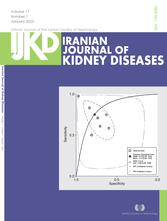Is CKD Screening Program Necessary in Developing Countries?
Abstract
Introduction. The prevalence of congenital anomaly of kidney and urinary tract (CAKUT) and related chronic kidney disease (CKD) may be increased in countries with higher rate of consanguineous marriage. Therefore, we evaluated the prevalence of CKD by biochemical and kidney ultrasound measurements in the firstgrade pupils. Methods. This cross -sectional study was carried on children aged 6 to 7 years. Urine analysis, serum creatinine, urine microalbumin to creatinine ratio and kidney ultrasound have been evaluated for participants. Results. 653 children were recruited to the study. Stage 1 and stage 2 systolic hypertension have been found in 6.5 and 1%, respectively. The percentage of stage 1 and stage 2 diastolic hypertension were 1.3 and 0.3%, respectively. Both weight Z-score and waist Z-score had positive correlation with systolic and diastolic blood pressure. Microalbuminuria (in 2.5%) did not have any correlation with the following factors: hypertension, body mass index, microscopic hematuria, glomerular filtration rate, kidney sonographic abnormalities or kidney parenchymal thickness and family history of kidney transplantation. GFR less than 90 mL/ min /1.73 m2 has been detected in 1.8% of the students. Only 1.7% had urine RBC more than 5 in each high-power field (hpf). Approximately 1.5% had anatomical abnormality of kidney and urinary tract (hydronephrosis or hydroureter). Conclusion. Considering the higher prevalence of elevated blood pressure and microalbuminuria in Iranian children, a CKD screening program based on evaluating microalbuminuria and blood pressure measurement is needed. However, irrespective of high prevalence of consanguineous marriage in Iran, using kidney ultrasound as a screening tool has not been recommended.
DOI: 10.52547/ijkd.7306
Downloads
Download data is not yet available.
Downloads
Published
2023-02-01
Issue
Section
ORIGINAL | Kidney Diseases
How to Cite
Is CKD Screening Program Necessary in Developing Countries?. (2023). Iranian Journal of Kidney Diseases, 17(1), 37-46. https://ijkd.org/index.php/ijkd/article/view/7306


